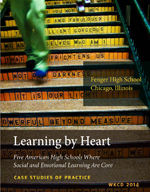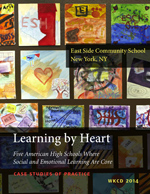
Learning by Heart: Social and Emotional Learning in Secondary Schools
FIVE AMERICAN HIGH SCHOOLS WHERE SEL IS CORE
Most SEL efforts have focused on the elementary grades, and most of the research documents discrete programs within schools. We know far less about the promises and challenges of SEL in middle and high school—and less still about what it takes to make social and emotional learning central to a school’s mission and inextricably linked to academics.
The five case studies presented here document the transformative power of social and emotional learning, and its connections to deeper learning, in five diverse American high schools.
In four of these schools, the links between academic and social-emotional learning were built into their DNA, although the designs and students served are decidedly distinct; each school had close to twenty years of experience forging these connections. The fifth school, Chicago’s Fenger High School, offered an extraordinary opportunity to observe educators embracing SEL as a strategy for turning around years of poor performance.
We took take a constructivist approach to our research. Rather than bring a list of contested issues to the schools visited, we worked the other way around. We asked administrators, faculty, and students to show us where in the school day social and emotional learning stood out for them, and what effects it had. We focused on effective practices as much as effective programs—another reflection of our constructivist instincts, but also a reminder that the best schools are learning organizations, continually inventing and measuring the effectiveness of practices rooted in their own particular circumstances. Our mixed research approach also made multimedia built on student and teacher voices one of the tools in our data gathering.
With one exception, we visited each school twice for several days, observing and interviewing as many students and faculty as possible and gathering images and voices from students and teachers alike.
In addition to the full case study, we have created a "Close-Up" for each school that examines a particular aspect of its SEL work: restorative practices at Fenger, developingt student agency at Springfield Renaissance, service learning and giving back at Quest, creating accountability through community at East Side, and soccer as unifier at Oakland International.
| LEARNING BY HEART: THE POWER OF SOCIAL-EMOTIONAL LEARNING IN SECONDARY SCHOOLS Effective Practices and Their Implications for Policy [DOWNLOAD PDF] |
NOTE: Links to videos, audio clips and slideshows—featuring student and teacher voices—are embedded in each case study, along with QR codes. “They Never Give Up” | Fenger High School, Chicago, IL by Barbara Cervone, Ed.D. In September 2009, Chicago’s Fenger High School became a poster child for urban school violence when rival gangs beat to death an honors student on his way home. Four years later, the school was making news again: as a turnaround school, whose staff did everything in its power to build a community of supports where failure was not an option. Transforming long-failing urban high schools like Fenger is a herculean effort. Committed leadership and staff along with supportive structures are critical. But so are a common language and purpose, intensive professional development, student engagement, high expectations, and a culture of trust and respect that prizes both collaboration and accountability. At Fenger one sees all of these elements, adapted to the school’s unique circumstances. Its commitment to social and emotional learning rivals that of any high school in the nation. |
|
A System of Working Parts | Springfield Renaissance School, Springfield, MA_ by Kathleen Cushman To start a school from the ground up resembles architecture. Imagining its future occupants, we make design choices based on dreams and ideals as much as practicalities. Slowly, we construct a system of working parts, and when its gears turn smoothly, everyone who enters the place can feel it. Springfield Renaissance School began with its own idealistic vision: a magnet middle and high school that would bolster the uncertain futures of youth in this diverse and hard-pressed Massachusetts city. Though nearby colleges and universities abound, 78 percent of Springfield’s school-age children live in poverty, and manufacturing jobs have dried up. In this context, the school set an ambitious goal: 100 percent college acceptance. To inspire and support the work ahead, it chose Expeditionary Learning (EL), a longstanding national school network that offered a well-documented approach, a cadre of experienced coaches, and a focus on social and emotional development in the service of academic excellence.
|
|
I Belong Here | Quest Early College High School, Humble, TX_ by Barbara Cervone, Ed.D. When Quest Early College High School won ASCD's “Whole Child Award” in 2011, it capped a long drive to create a school where every child was known well. When Quest opened in 1995 with under 200 students—against a Texas landscape where large is sacred—its founders were making a bold, if not controversial, wager: that bigger was not always better. It wasn't just size that set the school apart. At Quest, teachers “facilitate” learning and mastery takes precedence over grades. "Family,” an advisory structure that mixes students across grades, meets daily, stays together all four years, and provides encompassing support. Fridays, students spend four hours volunteering in the community, practicing empathy and giving back. When Quest became an early college in 2010, dual enrollment also became integral to the school's design. This is a school where students talk about mindsets--about belonging, valuing what is being learned, hard work and persistence, participation, and becoming mature.
|
|
Developing Agency from Community | East Side Community School, New York, NY by Kathleen Cushman The story of East Side Community School has a distinctively generational context, spanning four decades of New York City educational change. East Side is cherished for its bedrock commitment to community. In the tradition of John Dewey, East Side regards community as the prime mover of education in a democracy, and builds the habits of citizenship on mutually respectful relationships between family, staff, students, and community. It has kept its eyes on the core values it prizes: knowing all its diverse students well, and developing their agency equally in the social, emotional, and academic spheres. The school has a key partner in the nonprofit Facing History and Ourselves, whose curriculum challenges learners to wrestle with ethical dilemmas in history and their own lives, to reflect on choices made and roads not taken, and to choose to participate in positive ways in the future. The senior class inscription outside the school office reflects the effects they feel from their high school education: “You can take us out of East Side, but you can’t take East Side out of us.”
|
|
A Place to Make My Own | Oakland International High School, Oakland, CA by Kathleen Cushman The student-made banners above the walkway into Oakland International High School lend a ceremonial air of welcome to this school for new immigrants to the United States. Fluttering in a light breeze, their words and symbols evoke the lives, hopes, and beliefs of the youth who painted them: “We are immigrants.” “We dream of a United States without racism.” “We are a community.” Since its 2007 founding, in both design and daily life Oakland International has forged that sense of belonging with its students, who come from 33 countries and speak at least that many languages. As part of the Internationals Network of Public Schools (conceived in New York City in 1985 and now numbering seventeen schools and academies in three states) the school brings very heterogeneous groups of learners into project-based academic, arts, and technology classrooms, integrating English language development in all content areas. |




